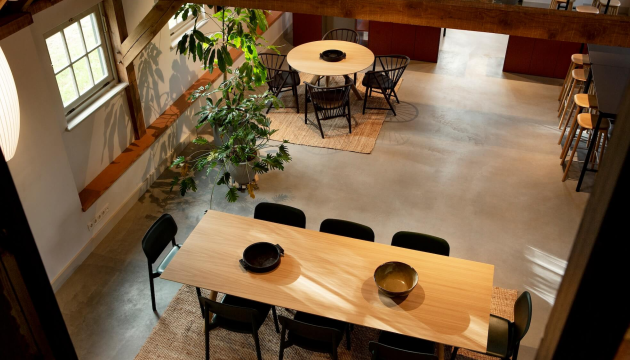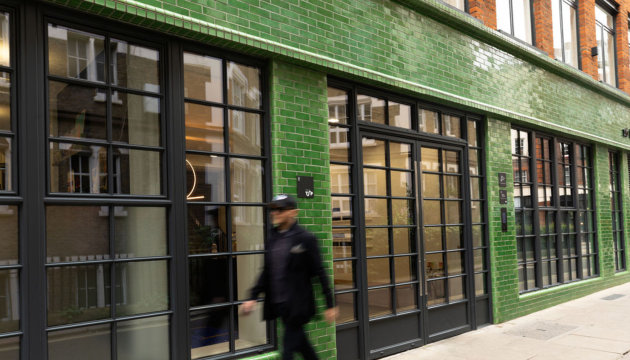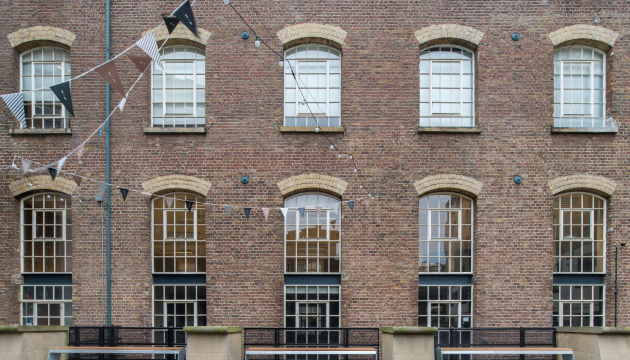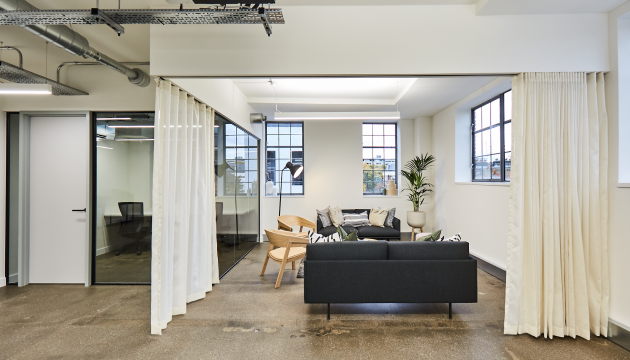We sat down with Shaun Simons, Founder of Compton, along with Tom Kemp, Co-Founder, and Louis Jacobs, Commercial Leasing Advisor from HK London – our joint agents for 60 Ironmonger and 79 Clerkenwell.
In this exclusive interview, they share valuable insights into prevailing occupier demands shaping the market in 2024 and their predictions for 2050.
Read on to discover the most pressing needs and trends in commercial leasing today.
How do you keep things fun and fresh in the world of property?
SS:
Since our launch in April 2022, Compton have been committed to setting ourselves apart by doing things differently.
Our approach to marketing is key. We always strive to push boundaries and explore innovative strategies to increase exposure for both our agency and our clients’ projects. By constantly challenging the status quo, we inject excitement into the industry, ensuring that our team remains at the forefront of creativity and our clients benefit from the best marketing solutions. Going viral with video is a big part of this in 2024.
As an example, check out our latest episode of Compton TV – The Strategy.
TK:
Take the time to celebrate achievements. Embrace technology to make the mundane better. Take advice from your elders and inspiration from the young.
LJ:
Networking – having the ability to liaise with peers and respected individuals in the industry who help broaden areas of expertise and provide different ways of thinking.
What are the top 3 most frequent requests you’re hearing from occupiers today?
SS:
Firstly, there’s a pronounced emphasis on well-designed workspaces. Modern businesses recognise the pivotal role physical environments play in motivating their workforce. As organisations move away from the remote work trend, creating offices that inspire and incentivise employees to be present is a consistent request.
Secondly, there’s a growing demand for strong ESG credentials. Today’s occupiers are increasingly conscious of sustainability and corporate responsibility. They seek spaces that align with their commitment to environmental and social values.
Lastly, occupier amenities play a pivotal role in attracting and retaining tenants. Communal roof terraces and business lounges are gaining prominence as essential components of a well-rounded office.
The desire for these shared spaces reflects a broader trend where occupiers are looking for environments that foster collaboration, relaxation, and community.
TK:
Best design, amenity, sustainability … in that order.
LJ:
Location is key – being within proximity to key transport links is heavily impacting company’s decision-making process when it comes to their office.
There is also heavy impetus on occupiers being within highly sustainable, design led inspiring workspaces.
The third area of focus is from employers looking to acquire the best buildings with the best amenity offering – whether that be podcasting studios like at 79 Clerkenwell or outdoor green spaces to encourage wellbeing. This is key to getting staff back into the office regularly while attracting and retaining the best talent.
The biggest change you’ve seen in the industry in the last decade?
SS:
The most significant transformation within the industry has undeniably been the paradigm shift in lease terms. A notable evolution has occurred in response to the dynamic needs of tenants who now seek heightened flexibility in their leasing arrangements. This demand for agility and adaptability has compelled landlords to revaluate and redefine their leasing structures.
TK:
The requirement of all of the answers to question 2 to be delivered prospectively by landlords rather than by the tenant.
LJ:
The shift in the traditional leasing market to provide occupiers with greater flexibility (in a sense to compete with the introduction of serviced offices) and the demand on landlord’s to deliver fully fitted and furnished ‘ready to go’ solutions of the highest quality.
In 2050, what will the office look like?
SS:
While the fundamental purpose of providing an inspiring and well-designed workspace remains unchanged, several transformative trends are poised to reshape the office environment.
Landlords, recognising the continued importance of delivering spaces that foster creativity and productivity, will need to navigate an increasingly dynamic and technology-driven landscape.
Flexibility will continue to be a cornerstone, with landlords adapting to the evolving needs of their customers.
The concept of flexibility will extend beyond lease terms to encompass versatile and adaptable spatial configurations, technology infrastructure, and amenities that cater to the diverse demands of future occupiers.
Technological integration will play a pivotal role, with smart offices becoming the norm. From advanced connectivity solutions to AI-driven workplace analytics, the office of 2050 will be characterised by seamless integration of technology, enhancing efficiency and providing a more personalised, responsive work environment.
In essence, the office of 2050 will be a dynamic and adaptive ecosystem that blends inspiring design with cutting-edge technology, flexibility, and a strong commitment to sustainability.
TK:
Post covid, the vast majority of business leaders have found that the desire to operate as people facing operations is stronger than ever, albeit with greater flexibility and always imploring latest technology.
I think this extraordinary stress test event proves that the physical office form will remain in 2050.
LJ:
The physical office is very much here to stay.
Fast forward to 2050 – I imagine the office will be a central hub for people to continue to come together and collaborate to enhance productivity and achieve best results.
The construction and refurbishment of offices will be led significantly by using sustainable building materials and the ever-evolving role of technology to maximise sustainability and efficiency.
I also believe there will remain a heavy impetus on buildings having adequate facilities to meet the demands of occupiers seeking to promote health and wellbeing within the workplace.
Featured Stories & Insights
 19th June 25
19th June 25
As Featured in: Flex and the City | How Zac Goodman made his mark in third sector property
TSP Founder and CEO Zac Goodman shares his remarkable journey. From analysing interest rates at...
Read More 17th June 25
17th June 25
TSP and NORNORM Collaborate to Redefine Office Spaces in London
LONDON, 17th June 2025 – TSP, a leader in property and community management, has announced...
Read More 12th June 25
12th June 25
6 Mistakes to Avoid in Property Maintenance
Property management and maintenance can be a seamless process. But small errors can quickly escalate...
Read More 9th June 25
9th June 25
5 Common ESG Requirements and How To Address Them
As ESG considerations become a driving force in business, organisations are under increasing pressure to...
Read More 2nd June 25
2nd June 25
SORP Changes: How Will It Impact Charity Real Estate?
Big changes are coming for how charities manage and report their leases. From January 2026,...
Read More 27th May 25
27th May 25
5 Ways Modern Flex Offices Boost Tenant Satisfaction
The workplace has evolved, and so have employee expectations. Teams want environments that inspire, adapt,...
Read MoreView all
